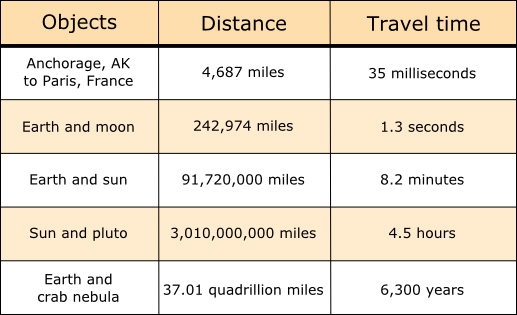When you turn on a flashlight, you don't have to wait for the light to reach your eyes. You don't have to wait for the light to reach all the dark corners you're trying to illuminate. Light travels too quickly for anyone to observe its speed without instruments -- so how quickly is it going, anyway?
It turns out that at 299,792,458 meters per second, light is the fastest thing in the universe, a speed limit that nothing else can surpass. Here's how quickly light can
travel:

Source: WolframAlpha.com
Fascinatingly, the fact that light has a constant speed regardless of the observer's position results in the theory of relativity. This theory yields an astonishing fact: objects moving more quickly experience the passage of time at a slower rate than objects at rest -- in other words, they age more slowly. To understand why, imagine two spaceships traveling very fast and firing lasers at each other and recording the time it takes for the laser burst to hit the other ship and bounce back. Now, to the ships, this is very straightforward: since the speed of light is constant, the time it takes to travel is simply the distance d divided by the speed of light c. But to a neutral observer, it takes longer for the packet of light to bounce between the two ships, since the light has to travel the additional distance created by the ships' motion. Therefore, time appears to be moving more slowly for the crews of the spaceships and more quickly for the stationary observers.
How does this affect us? Well, if you could engineer a vehicle capable of traveling at near-light speeds, you would effectively gain the ability to travel forward in time. A few months spent in the machine could translate into a "jump" of a few years! Although backwards time travel may be impossible, forwards travel is at least theoretically achievable.

